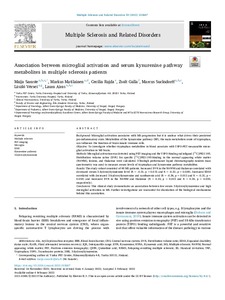Association between microglial activation and serum kynurenine pathway metabolites in multiple sclerosis patients
Saraste Maija; Matilainen Markus; Rajda Cecilia; Galla Zsolt; Sucksdorff Marcus; Vécsei László; Airas Laura
https://urn.fi/URN:NBN:fi-fe2022081153866
Tiivistelmä
Background
Microglial activation associates with MS progression but it is unclear what drives their persistent pro-inflammatory state. Metabolites of the kynurenine pathway (KP), the main metabolism route of tryptophan, can influence the function of brain innate immune cells.
Objective
To investigate whether tryptophan metabolites in blood associate with TSPO-PET measurable microglial activation in MS brain.
Methods
Microglial activation was detected using PET imaging and the TSPO-binding radioligand [11C]PK11195. Distribution volume ratios (DVR) for specific [11C]PK11195-binding in the normal appearing white matter (NAWM), lesions, and thalamus were calculated. Ultrahigh performance liquid chromatography-tandem mass spectrometry was used to measure serum levels of tryptophan and kynurenine pathway metabolites.
Results
The study cohort consisted of 48 MS patients. Increased DVR in the NAWM and thalamus correlated with decreased serum 3-hydroxykynurenine level (R = -0.31, p = 0.031 and R = -0.32, p = 0.028). Increased EDSS correlated with decreased 3-hydroxykynurenine and xanthurenic acid (R = -0.36, p = 0.012 and R = -0.31, p = 0.034) and increased DVR in the NAWM and thalamus (R = 0.33, p = 0.023 and R = 0.34, p = 0.020, respectively).
Conclusions
This clinical study demonstrates an association between low serum 3-hydroxykynurenine and high microglial activation in MS. Further investigations are warranted for elucidation of the biological mechanisms behind this association.
Kokoelmat
- Rinnakkaistallenteet [27094]
